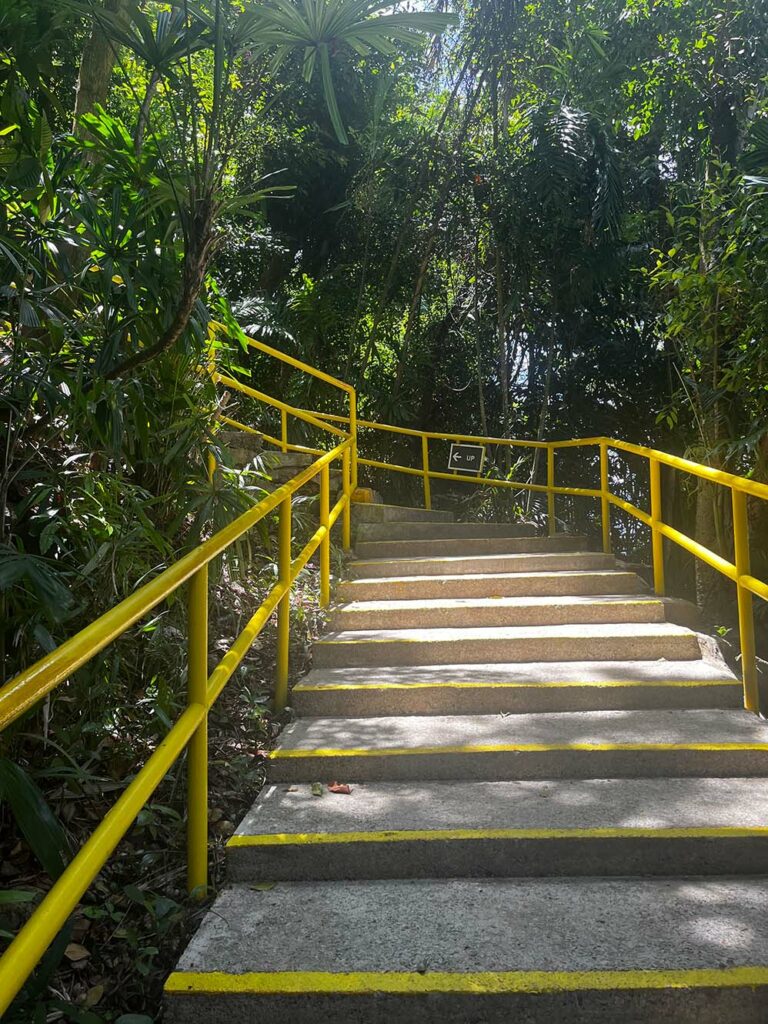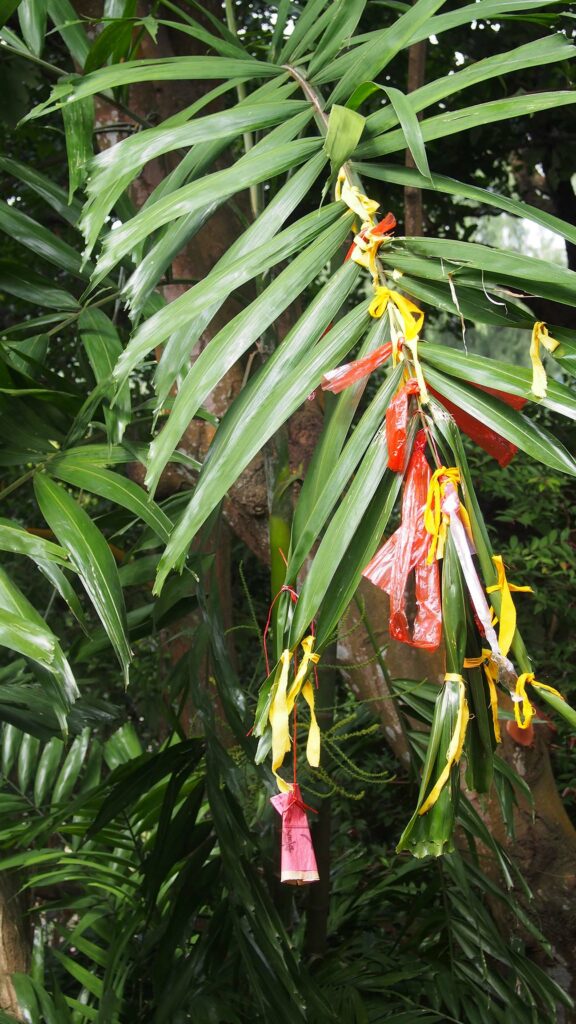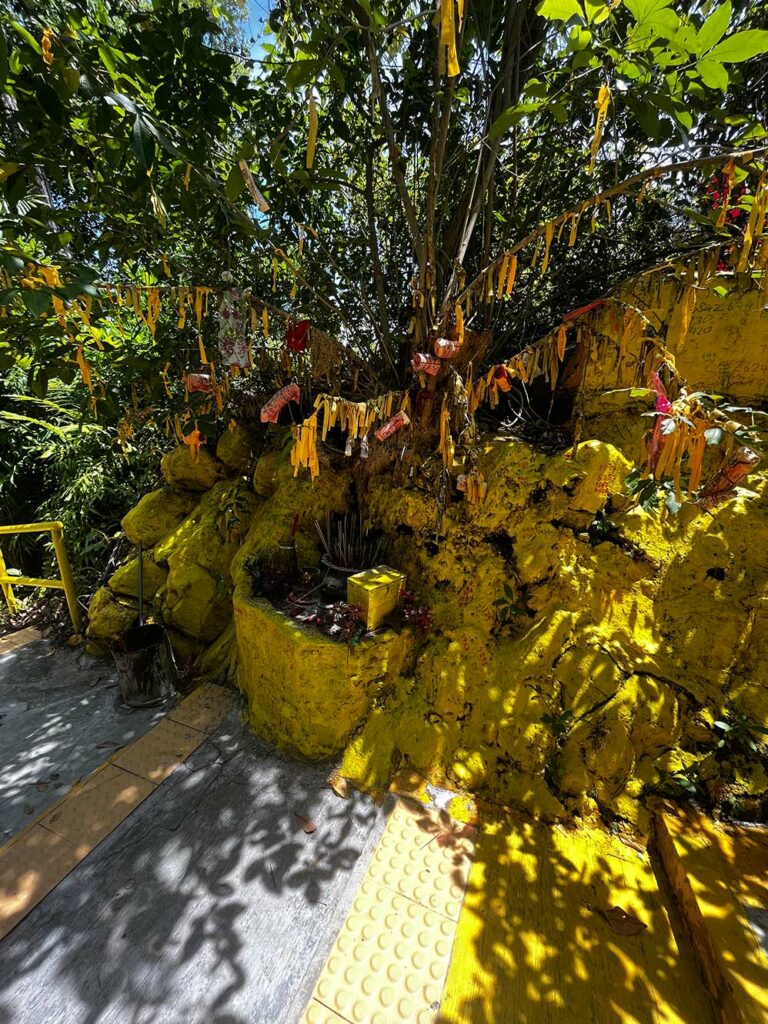Faisal Husni
On April 17, 2022, flames erupted on the peak of the hill on Kusu Island—an offshore island of Singapore—where resides a triumvirate of keramat graves of revered figures: Syed Abdul Rahman, his mother, Nenek Ghalib, and his sister, Puteri Sharifah (fig. 1). On this 8-hectare island also stands a Chinese Taoist-Buddhist temple west of the hill. The hill had recently experienced minor landslips in 2021. Now, a fire menaced the structure sheltering the graves. Firefighters rushed to the island, ascended 152 steps, and used seawater hosed from the jetty to combat the blaze. The shelter narrowly survived and at the time of writing was undergoing rounds of reconstruction (fig. 2). Despite the graves being the primary concern during this tragedy, I also worried about the trees covering the hill; trees which hosted offerings from keramat grave devotees and served as homes to birds, monkeys, reptiles and other hidden beings, natural or supernatural. Syed Abdul Rahman was believed to have died on the island in 1816 (Rivers 2003, 107) and Keramat Kusu Island has survived much since. Yet fire and landslips are not its biggest threat; land development is. Many keramat graves have been exhumed and demolished because of it. Could those trees be the answer to the continuing survival of these sacred graves?
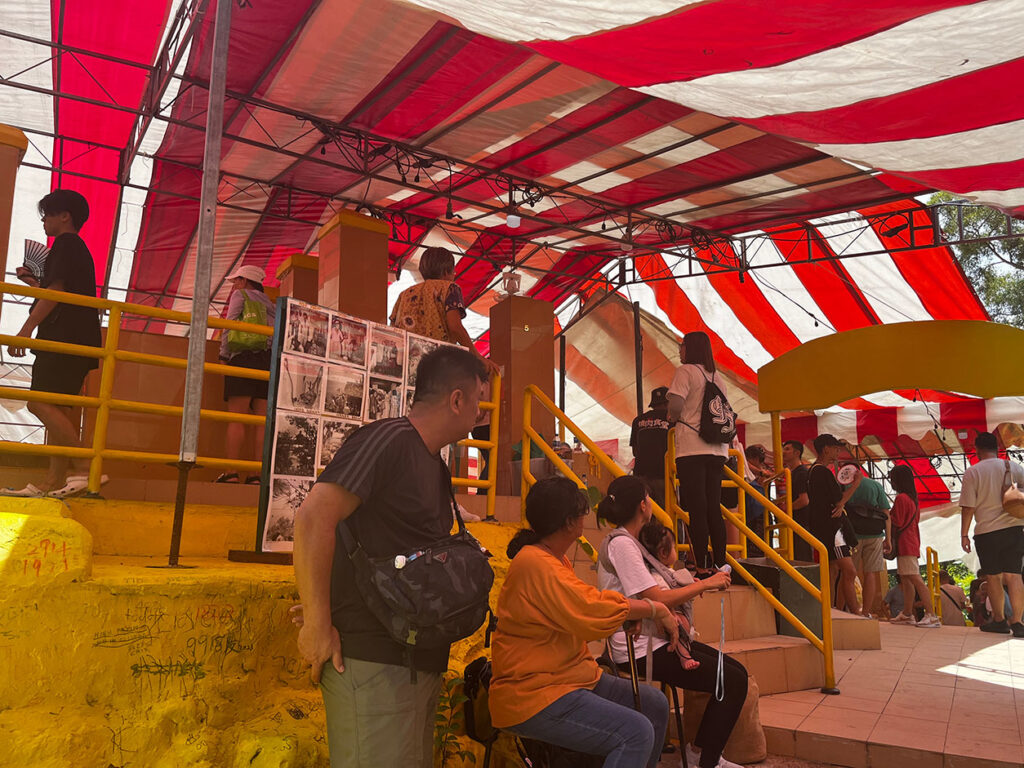
Keramat graves, found in various parts of the Malay and Indonesian World, are venerated graves that attract devotees seeking wishes and blessings, traditionally, housing the interment of a wali (Islamic saint-like figure; plural, awliya). They are thus part of the larger Islamic grave veneration tradition practised in many parts of the world, including Sufi tombs in Kerala (Dale et al., 1978) and Uyghur Islamic shrines in Xinjiang, China (Thum, 2014). Many from the Muslim communities of the Malay-Indonesian world—especially Singapore—consider keramat grave practices forbidden as they may be seen as worshipping another besides Allah (Isahak, 1995), and thus idolatrous and sinful (syirik) (Müller, 2017). It has also been viewed as an innovation to Islamic practices or bid’ah. The term is understood as “heresy”, however there are “classifications of ‘good’ innovations that were in accord with the Qur’an and the sunnah of the Prophet.” (Newby 2004, 44) Despite these concerns, in Singapore, there are still Muslims amongst keramat grave visitors, coming for blessings.
Keramat graves in Singapore include those of royalty, community leaders, individuals who suffered violent deaths, and miraculous corpses. The interred are usually Muslim or Malay individuals, yet they receive devotees from varied cultural and religious backgrounds. No religious writings dictate correct approaches, so visitors bring their own religious methods to the practice of keramat grave veneration. Thus, the tradition is not only informed by Islamic and Malay practices, but also Hindu, Buddhist, Taoist, Indian and Chinese traditions. Notably, some Singapore keramat graves draw devotees from abroad, with Keramat Kusu Island welcoming those from Thailand, Myanmar, and China.
My earlier research asserted that the sacredness of keramat graves—like Keramat Kusu Island—may extend beyond the graves themselves through their natural surrounding features, such as trees, hills, or water that are present at or near them. In this interpretation, these natural elements functioned as supporting extensions of keramat grave traditions (Husni, 2021). The present essay posits an alternative approach that does not privilege the graves over their natural surroundings in regard to their sacredness. Instead, it emphasizes both as equal elements, drawing inspiration from the phenomenon of sacred forests or groves.
Natural features may contribute to keramat grave traditions through their associated sacredness. They may also be viewed as sacred on their own terms by many cultural and religious communities. In this way, they may then contribute to the capacity for keramat graves to attract a varied demographic of devotees. In traditional Malay beliefs, trees have semangat (soul substance) (Winstedt and Seong, 1981) and may be used for spiritual practices (Skeat, 1900). Trees and naturally occurring water bodies, like the sea, may be abodes of spirits, which may be entreated for assistance (Skeat, 1900). Thus, it is common to find keramat graves “marked by the presence of a big tree” (Chambert-Loir, 2002). Notably, there are keramat trees with blessing-bestowing properties, similar to the keramat graves. In a historic case dating from the 1920s, a keramat tree was cut down to clear land for the building of a naval base in Singapore. It was believed that the violation led to the deaths of three British officials. Banyan trees—common at keramat grave spaces—are sacred to many communities, with urban Singapore hosting several Taoist-Buddhist banyan tree shrines, such as the Toa Payoh tree shrine (Campbell, 1971) which resisted felling and with aid, rose back from a storm-induced collapse.
Additionally, Singapore’s keramat sites are (or were) frequently near water which is also sacred to many communities. The practice of mandi safar, once popular amongst a segment of Singapore’s Muslim community, involved bathing in the sea to dispel ill luck or misfortune, performed on the third Wednesday of the Islamic month of Safar (Ahmad, 1988). There are also beliefs in sea deities like the Javanese Nyai Roro Kidul (Wessing, 1997) and the Chinese Mazu (Toh, 2017), and sea-connected figures like the Islamic Khidr, who is regarded as either a prophet or a wali in the Islamic tradition. Khidr was deemed a “patron-saint of sailors,” and there were traditions of invoking his name when launching boats across the Middle East and Northern India, as attested to in the 1990s (Omar, 1993). Hagiographies of awliya often include narratives connected to natural features such as trees and the sea. Syed Abdul Rahman of Keramat Kusu Island, like many awliya, was known to retreat into forested spaces for meditative purposes. A story tells of how his sampan travelled to and from the island without needing rowing, seemingly propelled by the sea (Rivers, 2003).
Natural features may inform the religious approaches and practices of keramat grave devotees. Sited on top of elevated hills, shrines like Keramat Kusu Island compel devotees to climb (fig. 3), thereby integrating the act of ascension into their spiritual journey; a feature embodied in other religious sites, such as Mount Arafat on the Arabian Peninsula or the Buddhist Borobudur temple in Central Java. Elevation allows for ascension to a higher plane, distancing from the mundane and profane ground level, with hills often symbolising Mount Meru; the cosmic mountain “at the centre of the universe, a place where gods were present” (Miksic, 2013). The branches of trees surrounding Keramat Kusu Island, on the other hand, have become receptacles for offerings from devotees, like living altars (figs. 4 and 5). With them, the keramat grave religious real-estate is not limited to the area within the shelter walls and can extend as far as the forest does, making the spatial limit of this sacredness difficult to determine.
In May 2023, I had the opportunity to visit Kaya Kinondo in Kenya, a national monument which is actively preserved by Digo Mijikenda communities, and was guided by a Digo community expert, Mr. Gerald Mudiwa Gambo. Kaya forests are sacred precincts of Mijikenda peoples, a collective group of nine diverse communities who live along the Kenyan coast. Kaya forest are spaces for social and communal religious practices, with “visible clearings in their centers and a system of deeply incised and well worn paths leading to and from these spaces” (The National Museums of Kenya, 2008). In the past, they also featured Mijkenda domestic spaces and thus “kaya” evokes the concept of “home” in many Mijikenda languages. Mr. Gambo emphasized Kaya Kinondo’s sacredness, where trees are protected from felling, serving as a space for communal religious activities with designated locations for specific rituals. Rather than a museumified institution, it is a living space of worship, with boundaries and order, unknown to the uninitiated, yet very material to its community. The foundation of this material? Trees.
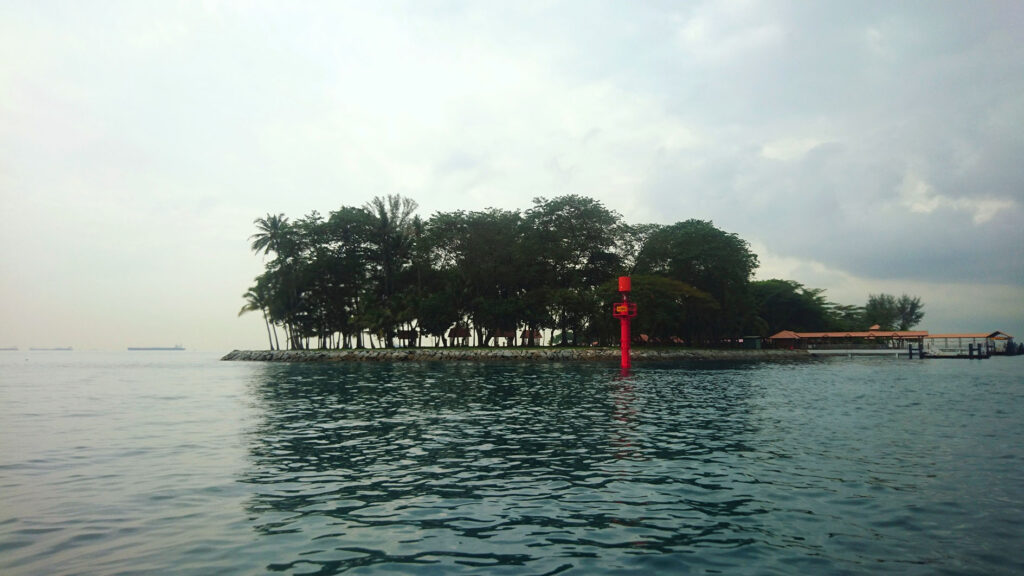
This visit prompted me to reconsider Keramat Kusu Island not only as part of the larger keramat grave tradition (and Islamic grave veneration tradition), but also as exemplary of the tradition of sacred forests or groves (fig. 6). Keramat graves were often erected upon pre-existing sacred spaces which may contain large trees that are considered sacred or natural features that are seen as “a manifestation of the supernatural world” (Chambert-Loir, 2002). It is conceivable that before the keramat graves were built, Kusu Island’s forested hill was already considered sacred. Though difficult to confirm, this might have even informed the site being chosen for the graves by their communities or the interred awliya. I posit that the sacred natural space served as validation, where “the worship of the keramat graves in these spaces allowed for a continuation of the [older] veneration of these sacred [natural] spaces through a different form, sustaining the relevance of these spaces to current worshippers” (Husni, 2021). While the devotees may view the graves as the primary focus of veneration or worship, within the tradition of Keramat Kusu Island, the graves, the forested hill and the sea function equally and holistically as a sacred grove with an inner sanctum which one climbs to.
Much like Keramat Kusu Island, Kaya Kinondo is still considered a space of religious practices and rituals to many in the community, and—at the very least—a heritage site. Viewing the kaya and keramat, not simply as traditions from two different regions, but phenomena with similarities within the larger Indian Ocean world may be useful. It may aid in understanding aspects of Keramat Kusu Island and its traditions that may not survive today or may have been ignored in studies of keramat grave heritage.
Due to Kaya Kinondo’s religious status as a sacred forest, it is a protected natural space and a sanctuary for rich biodiversity. An information board at Kaya Kinondo (a National Monument), states that it “contains 187 plant species of varying ecological importance and status,” some of which have medicinal properties (Ankei et al. 2020, 17). Mr. Gambo pointed out the kikoma or koma tree which may be used to treat mental health issues by putting the patient in a kind of sleep or “coma;” a homophone of koma, he highlighted. Kusu Island’s hill is also a habitat to various plants including the banyan tree (described above) and the ketapang tree—a coastal plant, used as traditional medicine (to cure vomiting and diarrhoea, for example) by some communities in Southeast Asia (Arini, 2017). While it does not seem like ketapang is harvested by people visiting the keramat graves today for that very purpose, we cannot know if this was the case in the past. In 2018, a Margaritaria Indica was identified on the hill; one of three identified instances in Singapore as of 2021. This species is locally considered to be critically endangered (Jong et al., 2021).
Animals also make up the biodiversity of kaya forests. The Kaya Kinondo information board lists various insects, birds and mammals that live in the sacred forest. Kusu Island, especially the hill, is also home to a variety of animals; including birds such as herons, monkeys, and reptiles such as monitor lizards. However, the biodiversity that may have benefited most from the Island’s lack of human intervention is its water ecosystem. Kusu Island went through land reclamation in 1975, which affected marine life near its shores. However, it received minimal land reclamation after, possibly because of its sacred status (due to the keramat graves and also the temple); allowing the marine biodiversity to heal and return, such as octocorals (Seah et al. 2015) and nesting hawksbill turtles.
There is always the risk of Keramat Kusu Island being demolished as the island is the property of the government and Singapore is a land-limited country. The high footfall during pilgrimage periods also raises concerns about littering, although I have never seen more than one or two plastic bags, which can be argued is one or two too many. However, viewing Keramat Kusu Island and the forested hill as a singular religious space, a sacred grove in the middle of the sea (instead of simply keramat graves situated within a forest), could offer a fresh view of its relevance, especially in light of how other sacred forests have avoided destruction due to their spiritual quality. In parts of India, sacred groves receive protection from their communities, and this is a form of ecological conservation of forests which are important and useful to the people (Gadgil, 2018). A number of the kaya in Kenya are given National Monuments status or listed as UNESCO World Heritage sites, ensuring that these Mijikenda community spaces will continue to be considered as sites of national importance, locally and internationally. This in turn helps in fundraising efforts for their conservation, and actively mandates their stewardship (Verschuuren et al. 2022). These accolades also come with national and international guidelines, which privilege preservation or “intactness of their forest surroundings.” This may also, however, potentially limit the communities’ use of the forests. Though achieving such recognition would require proper consideration and demand meeting many criteria and processes, I wonder if Keramat Kusu Island might benefit from it, especially to ensure the preservation and continued purpose of the land. But, for now, this keramat grave triumvirate, this sacred grove, will continue protecting itself by the sheer force of its sacredness, the adoration of its devotees, and a few firemen.
Faisal Husni is a researcher and curator with an interest in the art histories of Singapore and Southeast Asia. He holds a B.F.A. in Visual Communications and an M.A. (Research) from the School of Art, Design and Media (ADM), Nanyang Technological University (NTU). His research interests include multi-religious and multicultural heritage and spaces of worship, and religious and Islamic art and traditions of Singapore, Southeast Asia and the Malay world. However, they also extend to the history of post-war Malay cinema and Malay fashion and textile history. His main study is centered on keramat graves in Singapore and the Malay World, the focus of his M.A. research thesis, titled, “The Grave that Became A Shrine: The Lives of Keramat Graves in Singapore”, which was funded by the National Heritage Board. These are localised venerated graves of the Malay and Indonesian world.
He was assistant curator for Island Southeast Asia at the Asian Civilisations Museum (ACM). The most recent exhibition he curated was Her Kebaya (2023) at the Peranakan Museum, which celebrates not only the fashion history of the kebaya but also spotlights the lives of the women who wore them. As assistant curator at ACM, he also presented talks including Must We Decolonise the Museum? Sacred and Ritual Art and the Raffles Collection in Singapore hosted by SOAS in 2021 as well as And From Her Navel Grew Rice: Dewi Sri And Her Manifestations by ACM in 2021. In 2021, his essay, “The Shrine on the Green Hill by the Sea: Keramat Graves and their Relationship with Their Locations and Nature” was published in Antennae: The Journal of Nature in Visual Culture. This charted a new direction for his research to study the roles and significance of plants and animals in sacred traditions in Singapore, exploring the relationship between ecological and religious histories of the country and the wider region.
Read the next essay: “The Daka of Lamu” by Dhaval Chauhan >
Reference List
Ahmad, Hj Muhd Ariff. 1988. “Temasya Mandi Safar.” Berita Harian, September 23, 1988.
Ankei Yuji, Ankei Takako, and John Kahekwa. 2005. “Pilgrimage to a Kenyan Shrine Forest Kaya: a Congo-Japan Joint Research on Ecotourism among the Digo People of the Coast Province.” Bulletin of the Graduate Schools of Yamaguchi Prefectural University, 2005.
Arini, Diah Irawati Dwi Arini. 2017. “Pengetahuan Lokal Masyarakat Sulawesi Utara Dalam Pemanfaatan Pohon Hutan Sebagai Bahan Obat Tradisional.” Jurnal Masyarakat & Budaya 19 (2): 161-174.
Campbell, Bill. 1971. “A sacred banyan, smack in the heart of Toa Payoh.” The Straits Times, July 11, 1971, 10.
Dale, Stephen F. and M. Gangadhara Menon. 1978. “Nerccas: Saint-Martyr Worship Among The Muslims of Kerala.” Bulletin of the School of Oriental and African Studies, University of London 41 (3): 523-538.
Gibson-Hill, C. A. 1954. “Notes on the History of the Old Strait, 1580-1850.” Journal of the Malayan Branch of the Royal Asiatic Society 27 (1): 163-214.
Isahak, Zuraihan bte. 1995. “Cultural Practice versus Religious Injunctions: A Study of Keramat Worship in Singapore.” PhD diss., Department of Malay Studies, National University of Singapore.
Jong, Y. W., and Rushan Abdul Rahman, X. Y. Ng and Reuben C. J. Lim. 2021. “New localities of Margaritaria indica (Phyllanthaceae) in Singapore, with notes on fruiting and Propagation.” Nature In Singapore 14.
Mandal, Sumit K. 2012. “Popular Sites of Prayer, Transoceanic Migration, and Cultural Diversity: Exploring the significance of keramat in Southeast Asia.” Modern Asian Studies 46 (2): 355-72.
Miksic, John N. 2013. Singapore and the Silk Road of the Sea, 1300-1800. Singapore: NUS Press and National Museum of Singapore.
Müller, Dominik M. 2017. “The Bureaucratization of Islam and its Socio-Legal Dimensions in Southeast Asia: conceptual contours of a research project.” Max Planck Institute for Social Anthropology Working Paper, no. 187.
Newby, Gordon D. 2004. A Concise Encyclopedia of Islam. Oxford: Oneworld.
Omar, Irfan A. 1993. “Khidr in the Islamic Tradition.” The Muslim World 83 (3): 279-294.
Rivers, P. J. 2003. “Keramat In Singapore In The Mid-Twentieth Century.” Journal of the Malaysian Branch of the Royal Asiatic Society 76 (2): 93-119.
Seah, Jason Zhi Sheng, Nicholas Wei Liang Yap, and Lik Tong Tan. 2015. “Distribution and Abundance of Octocoral (Octocorallia, Alcyonacea) Communities at Three Southern Islands of Singapore.” Ocean Sci. J. 50 (2): 299-306.
Skeat, Walter W. 1900. Malay Magic: Being an Introduction to the Folklore and Popular Religions of the Malay Peninsula. London: Macmillan and Co., Limited.
Nomination Dossier for Inscription on the World Heritage List: The Sacred Mijikenda Kaya Forests, Kenya. Nairobi: The National Museums of Kenya, January 2008.
Thum, Rian. 2014. The Sacred Routes of Uyghur History. Cambridge, MA: Harvard University.
Toh Wen Li. 2017. “Statue of Chinese sea goddess Mazu from Meizhou temple makes maiden voyage to Singapore.” The Straits Times, July 6, 2017.
Verschuuren, Bas, Alison Ormsby and Wendy Jackson. 2022. “How Might World Heritage Status Support the Protection of Sacred Natural Sites? An Analysis of Nomination Files, Management, and Governance Contexts.” Land 11 (1): 1-18.
Wessing, Robert. 1997. “A Princess from Sunda: Some Aspects of Nyai Roro Kidul.” Asian Folklore Studies 56 (2): 317-353.
Wessing, Robert. 1999. “The Sacred Grove: Founders and the Owners of the Forest in West Java, Indonesia.” L’Homme et la Forêt Tropicale (January): 59-74.
Winstedt, Richard, and Seong Chee Tham. 1981. The Malays: A Cultural History. Singapore: G. Brash.


